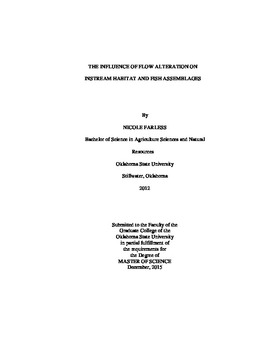| dc.contributor.advisor | Brewer, Shannon K. | |
| dc.contributor.author | Farless, Nicole Alyse | |
| dc.date.accessioned | 2018-06-29T14:40:55Z | |
| dc.date.available | 2018-06-29T14:40:55Z | |
| dc.date.issued | 2015-12-01 | |
| dc.identifier.uri | https://hdl.handle.net/11244/300338 | |
| dc.description.abstract | Globally, the instream habitat and biotic community of riverine systems are declining. The primary threat to rivers is flow regime alteration through dams, landscape alteration, and climate change. The natural flow regime is the natural pattern of a rivers flow. The flow regime is vital for maintaining abiotic and biotic stream components, including the thermal regime of rivers (i.e., average, maximum and minimum temperature). Increased stream temperature can influence species direct and indirect survival, as well as many life history events. The objectives of my Master’s research were to 1) develop flow-ecology relationships for stream habitat and fishes from the Arbuckle Mountain and Ozark Highland ecoregion and 2) determine the maximum thermal tolerance of stream fishes from the Arbuckle Mountains. Flow-ecology relationships were determined through the development of linear models for both stream habitat (i.e., deposited sediment, channel-unit diversity, residual-pool depth, and bankfull width-to-depth ratio) and fish assemblages (i.e., coarse-scale reproductive guilds and finer-scale reproductive-taxonomy guilds) to determine their relationship with flow alteration. These flow-ecology models showed that many stream abiotic and biotic characteristics were positively influenced by dynamic flow conditions, such as, increased magnitude and number of reversals. For example, stream fish diversity and reproductive guild diversity were positively influenced by increased maximum flows. Abiotic and biotic flow-ecology relationships can further improve the development of environmental-flow standards. I also determined the critical thermal maxima (CTM) of 15 species and the longer-term tolerance of 10 fish species from the Arbuckle Mountains. Longer-term studies had both a spring-fed and non spring-fed treatment that mimicked the thermal regime of Arbuckle Mountain streams. Comparing the results of the CTM and the longer-term study improves our understanding of species thermal tolerance and acclimation ability. Results showed that pelagic species had higher thermal tolerances than benthic species and had greater acclimation ability. Results from both objectives provide insight on the susceptibility of species to future flow and thermal alterations. This can be used to predict future fish assemblage changes and determine species of conservation concern. | |
| dc.format | application/pdf | |
| dc.language | en_US | |
| dc.rights | Copyright is held by the author who has granted the Oklahoma State University Library the non-exclusive right to share this material in its institutional repository. Contact Digital Library Services at lib-dls@okstate.edu or 405-744-9161 for the permission policy on the use, reproduction or distribution of this material. | |
| dc.title | Influence of Flow Alteration on Instream Habitat and Fish Assemblages | |
| dc.contributor.committeeMember | Long, Jim M. | |
| dc.contributor.committeeMember | Halihan, Todd | |
| osu.filename | Farless_okstate_0664M_14367.pdf | |
| osu.accesstype | Open Access | |
| dc.description.department | Natural Resources and Ecology Management | |
| dc.type.genre | Thesis | |
| dc.type.material | text | |
